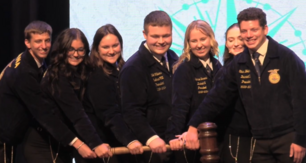
During the 95th Indiana FFA State Convention, 12 FFA members from across the state participated in a rigorous interview and selection process.
The following members were selected to serve Indiana FFA and its 13,000+ members as a 2024-25 Indiana FFA State Officer:
• President – Ethan Wolheter, Prairie Heights FFA
• Secretary – Christina Caldwell, Connersville FFA
• Northern Region Vice President – Stephanie Berenda, South Newton FFA
• Southern Region Vice President – Cale Williams, Terre Haute South FFA
• Treasurer – Kyatalin Baker, Switzerland County FFA
• Reporter – Sienna Alexander, Monrovia FFA
• Sentinel – Garrett Bolin, Indian Creek FFA

Weekly Review for June 21, 2024
This informal report by the Division of Entomology & Plant Pathology is a commentary on insects, diseases, and curiosities division staff encounter on a week-to-week basis. Comments and questions about this report are welcome and can be sent to your respective Inspector.
Our Website
Inspector Territories
Announcements
1) Indiana DNR’s 2024 Spongy Moth aerial treatments were completed as of Monday, June 17. Please visit our spongy moth website for more information on our treatment program.
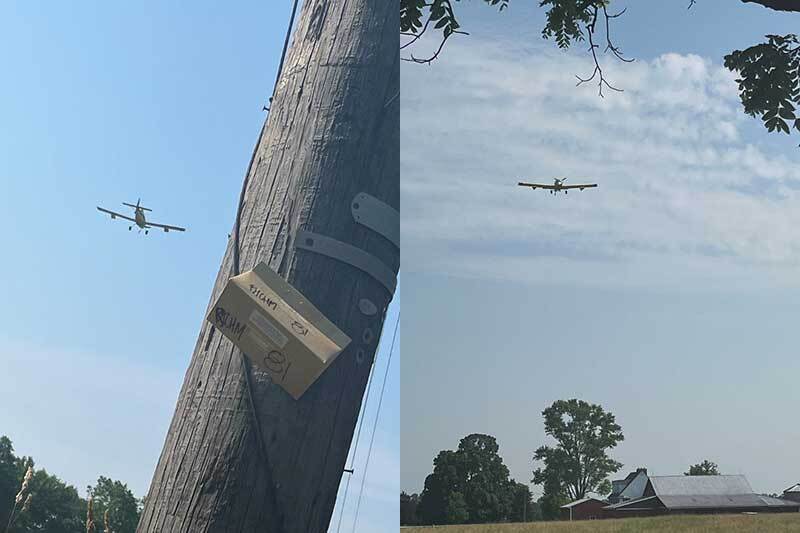 |
Photos: Spongy moth mating disruption treatment in Richmond, Indiana (photos by Jared Spokowsky)
2) Nursery inspector Will Drews received an award from SICIM (State of Indiana Cooperative Invasives Management) for his work with terrestrial invasive species at the 2024 Indiana Invasive Species Conference at Brown County State Park. Congratulations Will!
Reports
Diane Turner (Nursery Inspector & Compliance Officer) –
I have recently been seeing a good amount of red-headed flea beetle, Systena frontalis, damage specifically on hydrangeas in nursery production throughout Indiana. This small insect is about 1/6 inch long with a metallic black oval body and a reddish-yellow head. As the name suggests, this flea beetle jumps when disturbed, like a dog flea.
Adult beetles feed on the leaves of a wide variety of popular ornamental shrubs like hydrangea, azaleas, rhododendrons, weigela, and roses. Although the leaf-feeding rarely harms overall plant health, plants with a significant amount of damage are often too unsightly to sell.
 |
Left: Red-headed flea beetle, Systena frontalis, adult on hydrangea (Hydrangea spp.) Right: Feeding damage caused by the adult red-headed flea beetle on hydrangea leaves.
Kristy Stultz (Nursery Inspector & Compliance Officer) -
A lot of Christmas tree growers also dig nursery stock. While doing an inspection for one such establishment, I noted tags from last season. It’s important to remember to remove those tags, especially if they’re snugged on tight like this one. It won’t take that branch long to girdle itself.
One of the best things about inspecting any type of nursery is the opportunity to stop and smell the roses, or in this case, stop and watch a hover fly enjoy field sowthistle. Someone should enjoy this non-native flower.
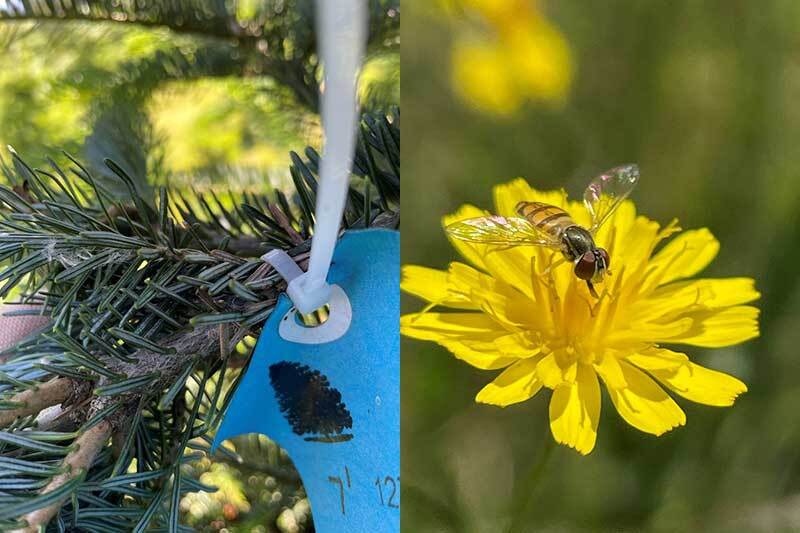 |
Left: Forgotten tag on Christmas tree which can lead to girdling. Right: Hover fly on non-native field sowthistle.
Jared Spokowsky (Nursery Inspetor & Compliance Officer) -
I wish I could say I had some good news for once but as I usually tell people if I show up it’s not good news. The first research paper confirming Tropilaelaps mites in western Russia on Ukraine’s border was released last month. You can read the whole paper (its only two pages) at this link. After Varroa every beekeeper should be familiar with this. It’s not in the western hemisphere yet but its pattern of spread indicates it could be in short order. There are very few people in positions like mine across the country so it’s most likely going to be found by a beekeeper first. Without early detection and reporting we have little chance of eradication before it becomes established. Currently the only thing that works at controlling these mites is formic acid and brood breaks.
I’ve been taking so many photos of what bees are working while doing inspections I am going to start to unload some more of them here. At the end of the season, I hope to put a complete list together with a few notes on preference.
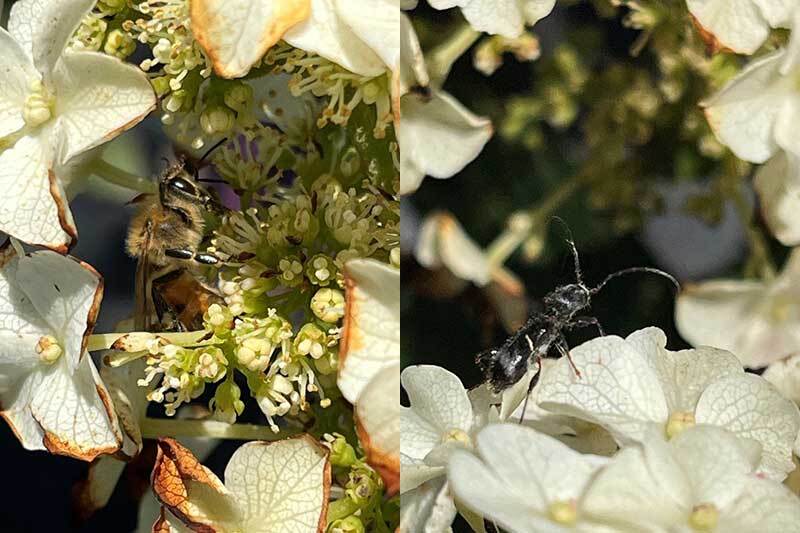 |
Left: Honeybee on Quickfire Hydrangea (I was quite surprised how much activity this had). Right: Quickfire hydrangea also had quite a bit of other insect activity including this longhorned beetle.
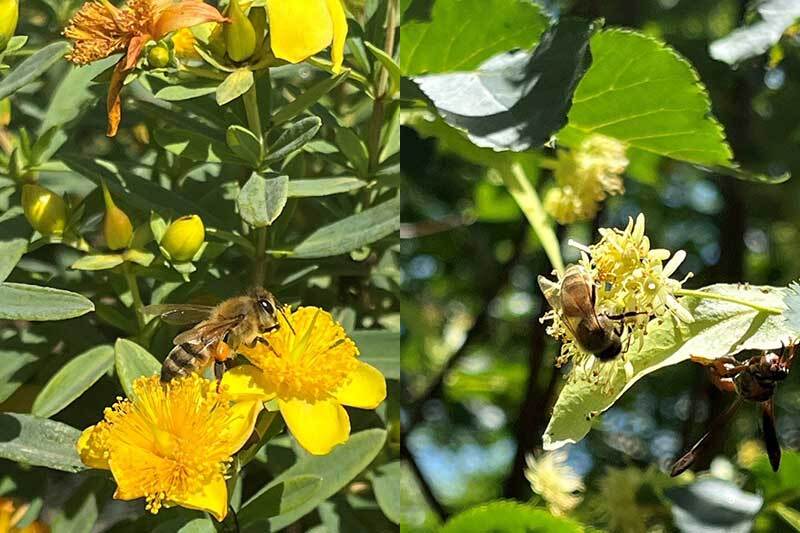 |
Left: Honeybee on Blue Velvet St. John’s wort (Sunburst is also a common variety that gets a lot of activity, I think all St. John’s wort does for that matter). Right: Honeybee and a paper wasp on a linden.
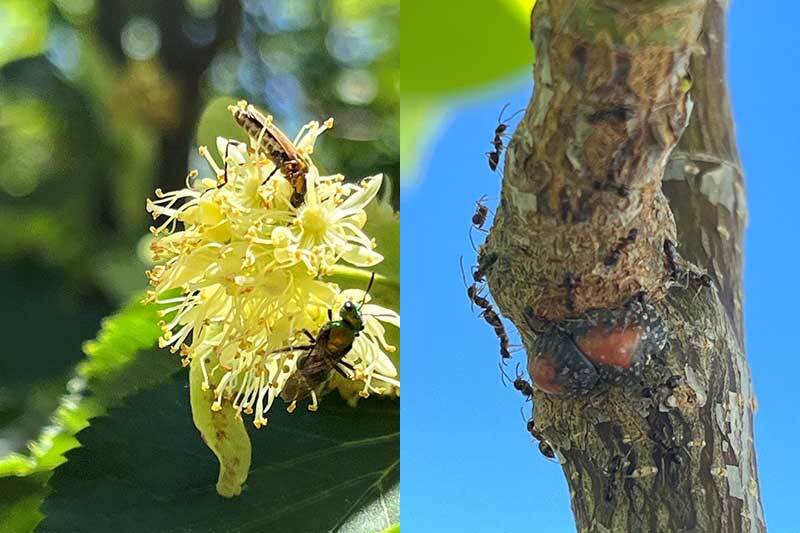 |
Left: Lindens attract quite a few insects including this soldier beetle and green sweat bee. Right: tuliptree scale.
In addition to bees I’ve seen a few other issues on nursery stock including tulip tree scale on tulip poplar, fall webworm on redbud, rose rust, fire blight on ninebark, quince rust on service berry, Japanese beetle, cottony maple scale and ambrosia beetles.
 |
Left: Fall webworm on redbud. Right: Rose rust (top of leaf).
 |
Left: Rose rust (bottom of leaf). Right: Rose rust close up.
 |
Quince rust on serviceberry.
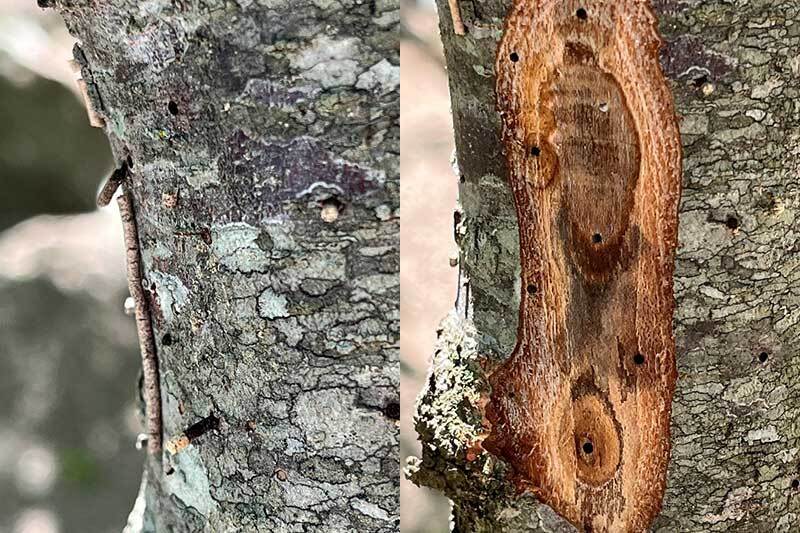 |
Ambrosia beetle damage and the same area showing the bark removed to see the hole more clearly.
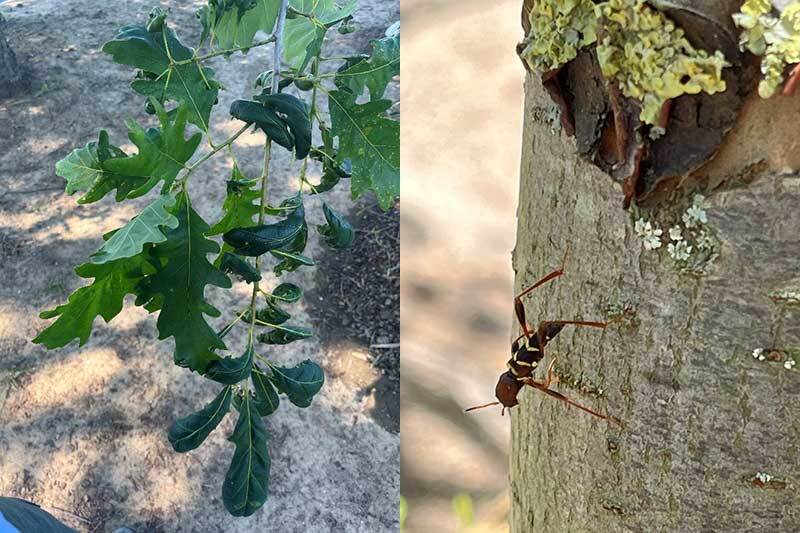 |
Left: White oak in a landscape with herbicide damage. I have noticed a marked increase in this type of damage since Dicamba resistant soybeans were released. This was not a nursery tree but an established landscape tree next to the nursery. Right: Redheaded ash borer. This is a native ash pest which can cause significant damage to ash but this is the first time I have seen it in quite a few years.
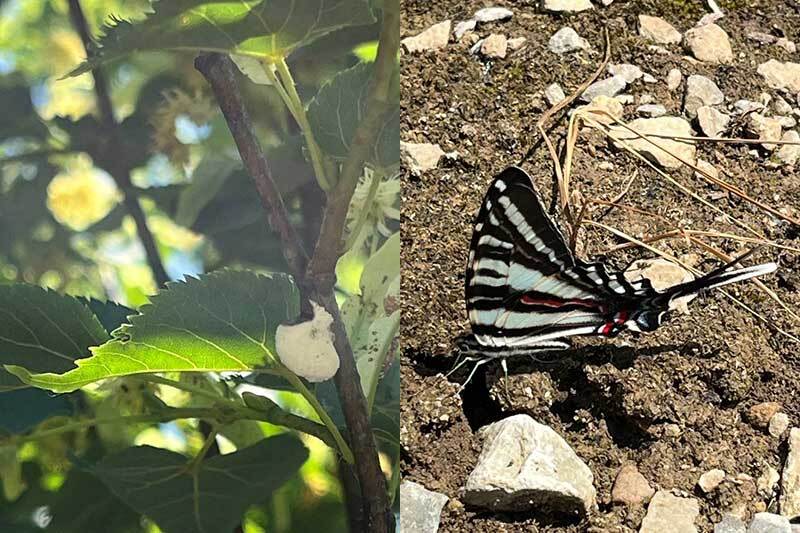 |
Left: Cottony maple scale on linden. Right: Zebra swallowtail. The host for this butterfly (which is one of our most impressive IMO) is the paw paw. I tend to only find these in VERY close proximity to paw paw. But I did have a nursery owner who planted a bunch of paw paw and within a couple years he had them flying around the nursery so I guess you could say “plant it and they will come.”
Eric Biddinger (Nursery Inspector & Compliance Officer) -
I have heard a meteorologist call our current weather pattern a “flash drought.” With that in mind, irrigation should be on everyone’s mind. Along with increased watering, be on the lookout for leaching and nutrient deficiency issues, especially in smaller containerized stock.
While working through a Christmas tree farm last week, I spotted this droopy white pine. Turns out this was white pine weevil damage. So often we catch this critter in the second year after the center leader is already dead. At this point, the larvae were already down to the next node and have already caused significant structural damage to this tree.
 |
White pine weevil damage.

The best small farm field day in Indiana is Thursday, July 25, 2024 at the Purdue Student Farm (1491 Cherry Lane, West Lafayette, IN. 47906) starting at 8:00 am.
Topics include: food safety updates, packhouse tours, weed & insect management, crop production, and more. Register online at: https://am.ticketmaster.com/purdue/smfarm.

Weekly Review for May 29, 2024
This informal report by the Division of Entomology & Plant Pathology is a commentary on insects, diseases, and curiosities division staff encounter on a week-to-week basis. Comments and questions about this report are welcome and can be sent to your respective Inspector.
Our Website
Inspector Territories
Jared Spokowsky (Nursery Inspetor & Compliance Officer) -
We are short on time but if anyone wants to submit their colony loss data for this year, the Apiary Inspectors of America and Auburn University are doing a colony loss survey. However, it’s only open until Friday, May 31.
Also, anyone interested in using oxalic acid extended-release strips I would encourage you to go to this website. Betterbee is going to be the sole distributor for Varroxsan, an oxalic acid impregnated strip that is labeled for extended use to control Varroa mites.
Kristy Stultz (Nursery Inspector & Compliance Officer) -
There seems to be a lot going on with roses this spring. Several dealer locations have had material showing heavy signs of rose mosaic virus. Symptoms can be variable since there are several viruses that contribute to the disease complex. I don’t remember ever seeing so many different symptoms on the same plant. One mode of transmission is through grafting or budding infected material onto healthy plant stock or vice versa. When receiving stock from any source, take some time to look it over. There’s no easy cure for rose mosaic virus. Sanitation of tools is important to remove the risk of spread to uninfected stock as well.
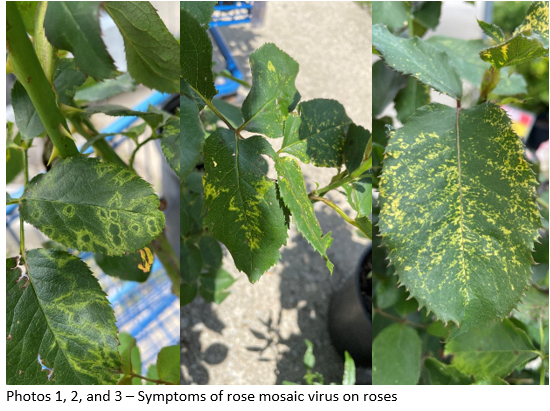
Eric Biddinger (Nursery Inspector & Compliance Officer) -
There has been all kind of talk about cicadas this year with the co-emergence of Brood XIII (a 17-year brood) and Brood XIX (a 13-year brood), though the ranges of these two broods do not overlap. On top of that, there are reports of some early emergence of Brood XIV (expected in 2025) and Brood XXIII (expected in 2028) occurring. There’s not much going on in my neck of the woods, but on a recent trip to Valparaiso I was blown away by the volume (noise) and volume (quantity) of cicadas.
As far as landscape damage is concerned, cicadas pose the largest risk to small and newly planted trees. While it is a little late to take protective measures such as netting, scouting trees for flagging and other signs of stress should continue throughout the summer, even after the cicada songs have faded away. For more information about all things cicada, visit cicadamania.com.
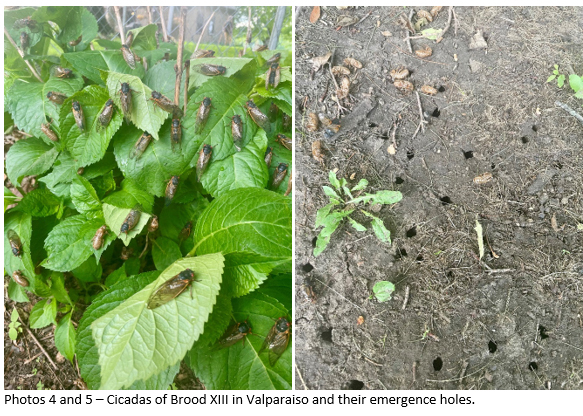

During the month of June, the Indiana State Department of Agriculture will accept submissions for the 17th annual Indiana Agriculture Photo Contest. The contest is open to all Indiana residents and was created to recognize the hard work and contributions of Hoosier farmers, as well as the beauty of the state’s agricultural landscape.
“Each and every Hoosier is welcome to submit an entry to the contest,” said Lt. Gov. Suzanne Crouch, Indiana's Secretary of Agriculture and Rural Development. “No matter the camera equipment you own, we encourage you to submit your best images showcasing Indiana agriculture.”
Participants are encouraged to submit photos reflecting the wide array of agriculture. The categories photos can be entered under are:
- On the Farm: Showcasing any building, piece of equipment or activity that is a part of life on an Indiana farm.
- Faces of Agriculture: Featuring those who grow and produce food, fuel and fiber in Indiana.
- Agritourism: Spotlighting Indiana’s seasonal and agricultural destinations, such as orchards, wineries and farmers markets.
- Conservation: Highlighting Indiana’s natural beauty with landscapes, water and wildlife.
In total, ten winners will be selected: two from each category and two overall. Winners will be invited to attend a special ceremony at the Indiana State Fair, where they will be recognized and receive certificates from Lt. Gov. Crouch and Indiana State Department of Agriculture Director Don Lamb. Contest winners will also have their photographs featured in the offices of the Lt. Governor’s Family of Business in Indianapolis throughout the year.
“Indiana agriculture is a beautiful thing and we are blessed to be surrounded by so much of it,” Lamb said. “I look forward to seeing how that beauty is captured in this year’s contest."
Contestants can submit up to five photos in digital format accommodated by a submission form for each photo. Photos will be evaluated based on creativity, composition and category representation. Entries must be submitted by 5:00 p.m. (ET) on June 30, 2024.
Click here for entry forms, guidelines and criteria or visit ISDA.IN.GOV
Order Your Indiana Grown Holiday Boxes
30 Oct 2024
Purdue Extension & Indiana Forage Council Hosting Virtual Forage Quality Virtual Seminar
29 Oct 2024
Congresswoman Houchin Cosigns Letter Urging Farm Bill Reauthorization
28 Oct 2024
Purdue Extension Hosting BQA Trainings
25 Oct 2024
Over 100 Indiana FFA Members Prepare To Compete On The National Stage
17 Oct 2024
Apply For Grants From Indiana Grown
17 Oct 2024
Washington County 4-H Junior Leaders Hosting Annual Cheeseball Fundraiser
15 Oct 2024
Washington County Plat Book For Hunting Season Available At Purdue Extension
15 Oct 2024
Congratulations CDE Teams
09 Oct 2024
Forestry & Entomology Contest
04 Oct 2024
Free Soil Sampling Program Available For Indiana Farmers
30 Sep 2024
USDA and Indiana Expand Their Successful Conservation Partnership
30 Sep 2024
DNR Weekly Review for September 26
26 Sep 2024
Purdue Extension & 4-H Annual Meeting/Banquet is Monday, Oct. 21
25 Sep 2024
RSVP By Oct. 14 For Purdue Extension & 4-H Annual Meeting/Banquet
25 Sep 2024
Pesticide Applicator Programs Are November 12
25 Sep 2024
Free Soil Sampling Program Available For Indiana Farmers
25 Sep 2024
Midwest Hair Sheep Sale At Salem October 5
17 Sep 2024
It's Harvest Season--Watch For Farm Equipment On Roads
14 Sep 2024
Goat Association Holding Annual Meeting
04 Sep 2024
DNR Weekly Review for August 28
29 Aug 2024
DNR Weekly Review for August 21
21 Aug 2024
DNR Weekly Review for August 14
14 Aug 2024
103 Historic Farm Families Presented Hoosier Homestead
14 Aug 2024
Indiana's Highest Agriculture Honor Awarded
09 Aug 2024
2024 Indiana Agriculture Photo Contest Winners Announced
09 Aug 2024
Harrison County Cattleman's Field Day, August 24
08 Aug 2024
DNR Weekly Review for August 7
07 Aug 2024
$2 Million Provided To Indiana Food Banks Through State Department of Agriculture
05 Aug 2024
DNR Weekly Review for July 31, 2024
31 Jul 2024
SalemLeader.com
Leader Publishing Company of Salem, Inc.
P.O. Box 506
117-119 East Walnut Street
Salem, Indiana. 47167
Phone: 812-883-3281 | Fax: 812-883-4446
Business Hours:
Mondays through Fridays, 9:00am - 5:00pm
News:
news@salemleader.com
Office:
office@salemleader.com
Publisher:
publisher@salemleader.com
Business
- More Business News
- Go To Guide
- Business Directory
- Real Estate
- Auctions
Education
- More Education News
Opinion
- Editorials
- Letters to the Editor
- Columns
- Unsung Heroes
- Days Gone By
- In the Garden
- Guest Columns
- Reader's Poll
- Salem Leader Forum
- Questions and Answers
Church
- Bible Aerobics
- Church News
- Church Directory

























